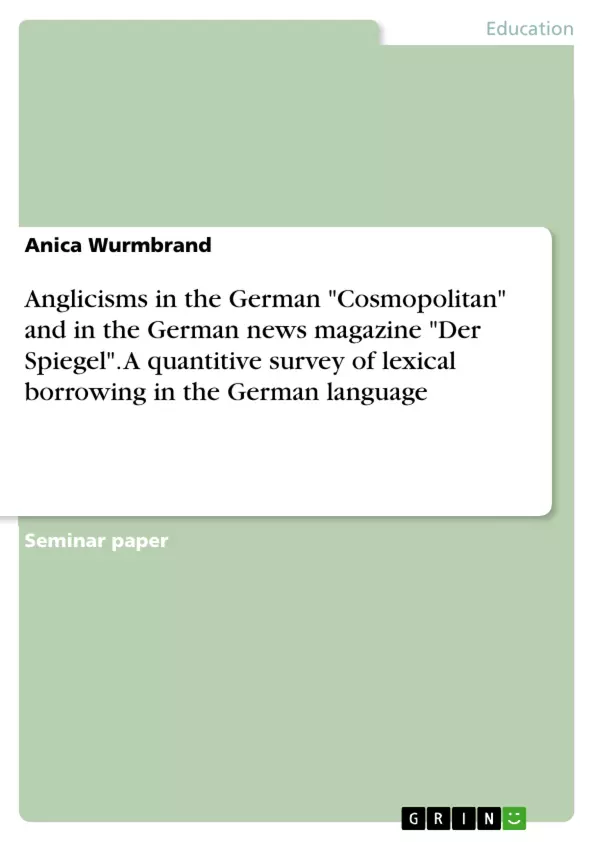The following paper is a research on the quantitative use of Anglicisms in two German magazines. The analysis will feature a selection of two issues of the German Cosmopolitan and Spiegel from December 2015. I chose these magazines because this type of material has not been considered in studies yet. There are many researches about the usage of Anglicisms in Spiegel over the years, or the integration of Anglicisms in advertisements found in magazines. As there is a gap of statistics including the comparison of the number of Anglicisms in a news magazine and a lifestyle magazine, I chose it to become the topic of this seminar paper. Further, this paper will analyze the usage of Anglicisms and their percentage distribution with regard to the different word classes.
First, I will give a comprehensive overview over Thomason (2001) and Winford’s (2003, 2010) theories of language contact and borrowing. Following that, I will give some definitions concerning linguistic jargon and give samples of how Anglicisms are integrated into the German morphological and inflectional pattern. The main part of this paper will be the evaluation of the data I collected and the comparison of the quantitative impact of Anglicisms in Cosmopolitan and Spiegel. I conclude with a closer examination of the compounds found in the two magazines.
Inhaltsverzeichnis (Table of Contents)
- Introduction
- Theoretical Part
- Definition of language contact
- Definition of borrowing
- Defining and Integrating loanwords
- Nouns
- Adjectives
- Verbs
- Compounds and Phrases
- Methodology
- Practical Part
- Quantitive impact of anglicisms
- Cosmopolitan
- Spiegel
- Comparison
- Analysis of Compounds
- Cosmopolitan
- Spiegel
- Comparison
- Quantitive impact of anglicisms
- Conclusion
Zielsetzung und Themenschwerpunkte (Objectives and Key Themes)
This paper is a research on the quantitative use of anglicisms in two German magazines, Cosmopolitan and Der Spiegel. The analysis will feature a selection of two issues from December 2015. The paper aims to fill a gap in existing research by comparing the number of anglicisms in a news magazine and a lifestyle magazine. It will analyze the usage of anglicisms and their percentage distribution with regard to different word classes.
- Language contact and its influence on language change
- The phenomenon of lexical borrowing and its integration into German
- Quantitative analysis of anglicisms in German magazines
- Comparison of anglicism usage between Cosmopolitan and Der Spiegel
- Analysis of compound words formed with anglicisms
Zusammenfassung der Kapitel (Chapter Summaries)
The introduction sets the context for the research, highlighting the prevalence of lexical borrowing and the existing gap in research regarding anglicism usage in German magazines. The theoretical part defines language contact and borrowing, providing key concepts from Thomason and Winford's work. It further explores the integration of anglicisms into German morphology and inflection.
The practical part presents the quantitative analysis of anglicisms in both magazines, comparing their occurrence and distribution across different word classes. The paper also delves into the analysis of compound words formed with anglicisms, examining their formation and usage in both publications.
Schlüsselwörter (Keywords)
The paper centers around the key concepts of language contact, lexical borrowing, anglicisms, quantitative analysis, and the comparison of anglicism usage in German magazines, focusing on Cosmopolitan and Der Spiegel. It examines the integration of anglicisms into German morphology and inflection, particularly through the analysis of compound words.
- Citar trabajo
- Anica Wurmbrand (Autor), 2016, Anglicisms in the German "Cosmopolitan" and in the German news magazine "Der Spiegel". A quantitive survey of lexical borrowing in the German language, Múnich, GRIN Verlag, https://www.grin.com/document/371039



